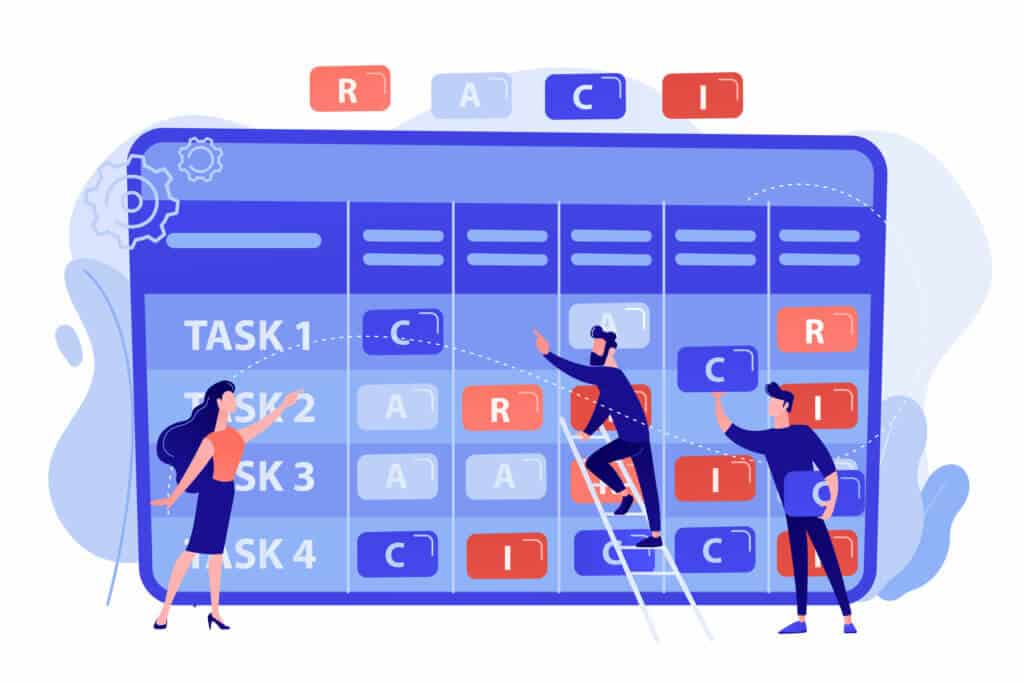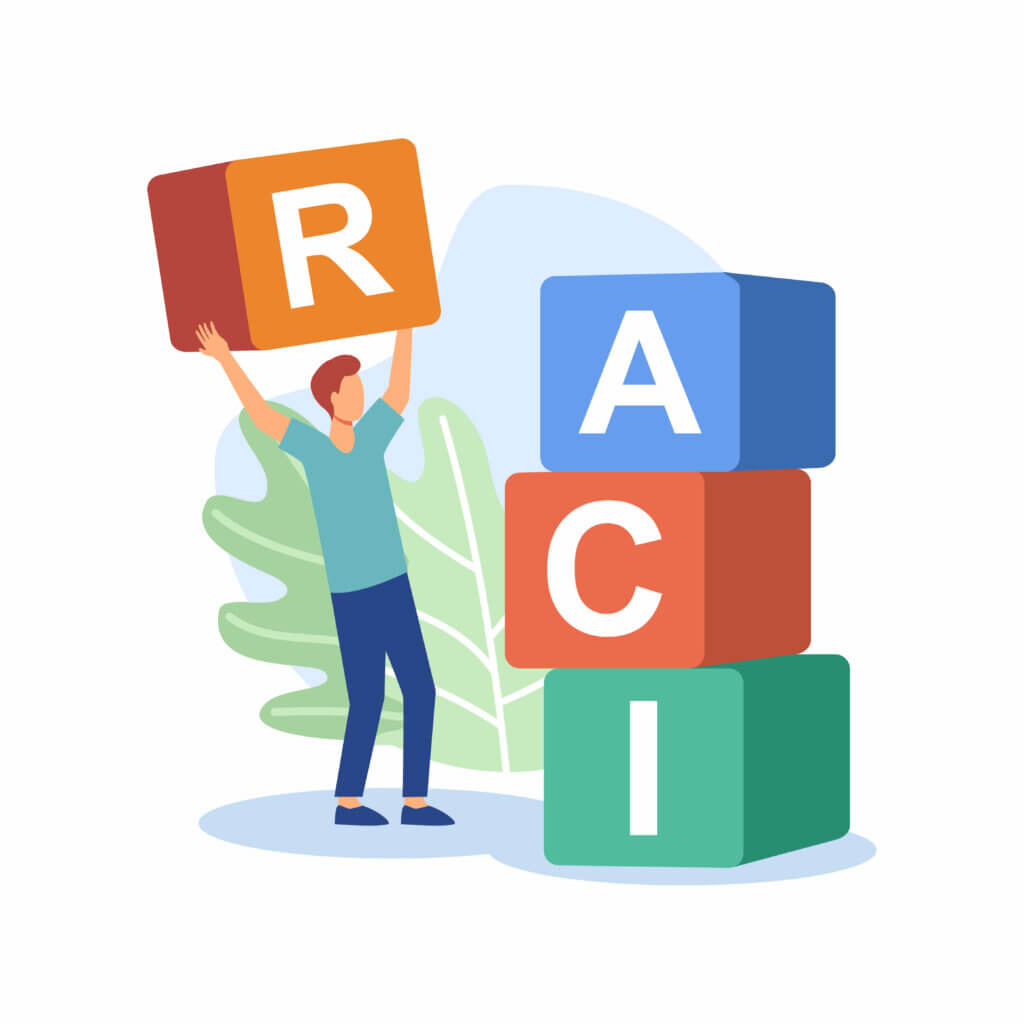The RACI model is a simple project management tool to help you plan and communicate your project. RACI is an acronym for Responsible, Accountable, Consult, and Inform. It helps you to better manage projects by clearly defining the roles and responsibilities of the people involved in your project.
Project managers commonly use the RACI model when working on larger projects that stretch across multiple departments. This is due to the fact that RACI is fully customizable, giving you the flexibility to use it according to your project deliverables.

Using a RACI chart also allows project managers to assign tasks and track the progress of the team. This clear definition of project roles is crucial as it gives stakeholders a clear understanding of project roles.
The RACI matrix is also called Responsibility Assignment Matrix (RAM), or a Linear Responsibility Chart (LRC). Even though it is hard to pinpoint who exactly created LRC, it is believed that LRC was originally created in the 1950s. Various changes to the model eventually transformed it into the RACI matrix that we know today.
If you’re a project manager looking to improve the productivity of your team, check out our list of the best online project management tools. With this list, you can find the best project management software to help you manage complex projects and tasks.
What Does RACI Stand For?
RACI is an acronym that stands for Responsible, Accountable, Consult, and Inform. A RACI chart is a matrix or simple diagram used to map task roles and responsibilities. The benefit is that it provides more granular detail about who is doing what on a project as compared to traditional basic task list assignments.
Here is how each of the 4 components is defined:
- Responsible. These are the people who actually do the work and are responsible for completing the task. This would usually fall into the hands of executives or individual contributors.
- Accountable. These refer to the responsible party accountable for the deliverables. Usually, people in this role are those in managerial roles. Accountable personnel are often those that delegate tasks to the Responsible role players.
- Consult. These are the people who were consulted for this task. They can offer expert advice but is ultimately not responsible for this project. Think of this person or group as an advisor or a consultant that you go to before making any decisions.
- Inform. These are the people who need to be in the loop regarding this project. This usually falls into the hands of senior management who have delegated the project to other line managers.
As you already now know, the RACI matrix is flexible. This means that even though employees may be skilled in multiple roles, ideally you would want to assign only one role to each employee. This allows them to focus their attention on ensuring that they’re fully accountable for a certain project task.
RACI’s versatile nature also means that you do not necessarily have to assign all the roles in your project. There is no point in engaging a consultant for simple tasks.
Breaking down a project and then using the RACI model to delegate tasks ensures that everyone involved in the project is clear about their roles and responsibilities. Responsibility and accountability are both prerequisites to a successful project, especially when it comes to larger projects.
Using a RACI matrix ensures that your team is on track to hit project milestones as scheduled.
How to Create a RACI Matrix?
To create a RACI chart, you first need to create a table to list your project deliverables and the persons involved. After that, assign the different RACI roles to each person in relation to their assigned task.
For example, if Jenny is the accountable manager for Task A, list the cell which intersects her name and task as ‘A’. Repeat this process for everyone involved in the project.
| Project A | Jenny | Rob | Alison | Mike |
| Task A | A | R | I | C |
| Task B | C | I | R | A |
| Task C | R | C | A | I |
| Task D | I | A | C | R |
When done correctly, you can enjoy a bird’s eye view of everyone’s roles and responsibilities simply by looking at the spreadsheet. For bigger projects, we would recommend color-coding your cells to gain better clarity on the project.
RACI Matrix Best Practices
In order to use RACI effectively, there are a few guidelines to take into consideration.
- Only 1 R/Responsible role per task. If you have multiple people responsible for a particular task, you could end up complicating things further. Having multiple R’s could lead to the same deliverable being delivered multiple times more than what is actually needed. Worse, your project team might be unsure of who’s actually responsible for the work, leading to the task not being completed.
- Only 1 R/Responsible role per person. Even though each person can be responsible for multiple tasks in a project, it’s best not to. This is to keep them focused on one task at a time, thus preventing any sort of ambiguity.
- Each task should only have 1 A/Accountable role. This ensures that the task is being monitored by one accountable manager only. Having more than one accountable role is redundant as there are other tasks that need to be accounted for.
- Responsible and Accountable are mandatory. When it comes to RACI, every single task has to have a responsible person and another accountable party. This ensures that deliverables are delivered on time and to specification.
- Consultants are not mandatory. Not all tasks are complicated enough to warrant a consultant. However, if you do work with a consultant, make sure that information is communicated clearly both ways so that you can get the job done.
- Keep the project team informed. This is probably the simplest thing to do, but also the most crucial. Keeping everyone informed once updates are available ensures that your project can proceed without hiccups.
By following these steps, your project will have just the right amount of responsible and accountable parties to ensure its success.
When Should You Use A RACI Chart?

A RACI chart helps to clearly define the roles and responsibilities of everyone involved in the project. The most ideal scenario is to have everyone align on the RACI chart at the beginning and then carry on with their respective tasks.
RACI helps you to optimize your team according to everyone’s strengths. You’re able to assign tasks to specific people and ensure that everyone is clear on what they have to do. This limits misunderstandings when the project is underway.
Having a RACI chart that is accessible to all stakeholders will help to streamline communication within the project team. Whenever a problem pops up, your team knows exactly who to look for if they need help with a task by viewing the chart.
This limits constant back-and-forth communication, and instead promotes focus and improves team productivity.
Try out our free RACI chart template and get a headstart on creating your first RACI chart!
🤖 Custom AI Agents: Deploy AI agents to automate your workflow. Run them in the background or call using custom /AI commands.
🪄 AI Generator: Describe what you’re working on, and Taskade will do the rest — tasks, projects, workflows, and much more.
✏️ AI Assistant: Use the AI Assistant to generate and edit content, prioritize tasks, generate ideas, and much more, powered by GPT-4 Turbo.
🗂️ AI Prompt Templates Library: Access hundreds of AI prompt templates designed for personal and business projects.
And much more…


